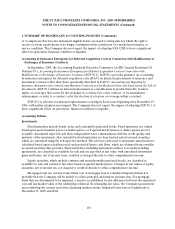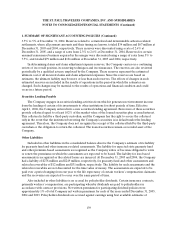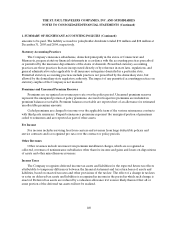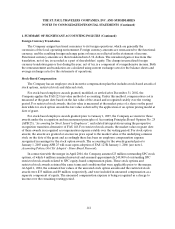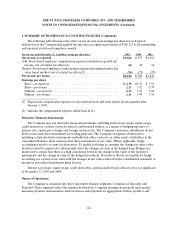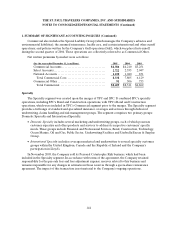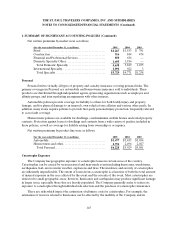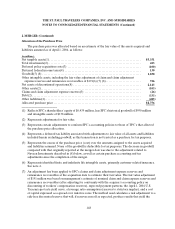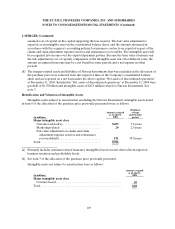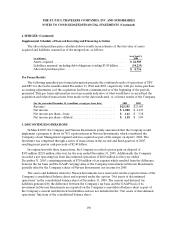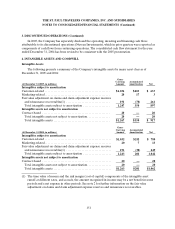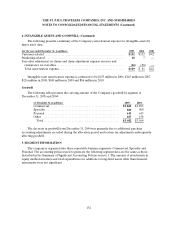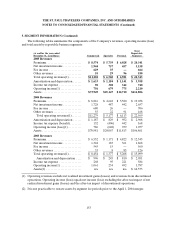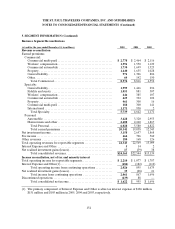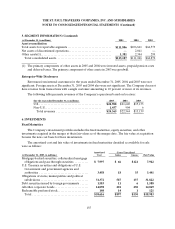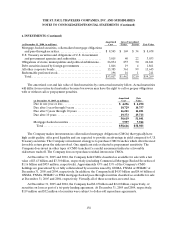Travelers 2005 Annual Report Download - page 158
Download and view the complete annual report
Please find page 158 of the 2005 Travelers annual report below. You can navigate through the pages in the report by either clicking on the pages listed below, or by using the keyword search tool below to find specific information within the annual report.THE ST. PAUL TRAVELERS COMPANIES, INC.AND SUBSIDIARIES
NOTES TO CONSOLIDATED FINANCIAL STATEMENTS (Continued)
146
1. SUMMARY OF SIGNIFICANT ACCOUNTING POLICIES (Cont inued)
insureds to access portions of the impacted areas, the complexity of factors contributing to the losses, the
legal and regulatory uncertainties and the nature of the information available to establish the reserves.
Complex factors include, but are not limited to: determining whether damage was caused by flooding
versus wind; evaluating general liability and pollution exposures; estimating additional living expenses; the
impact of demand surge; infrastructure disruption; fraud; the effect of mold damage and business
interruption costs; and reinsurance collectibility. The timing of a catastrophe’s occurrence, such as at or
near the end of a reporting period, can also affect the information available to the Company in estimating
reserves for that reporting period. The estimates related to catastrophes are adjusted as actual claims
emerge.
Terrorism Risk Insurance Act of 2002 and Terrorism Risk Insurance Extension Act of 2005
On November 26, 2002, the Terrorism Risk Insurance Act of 2002 (the Terrorism Act) was enacted
into Federal law and established the Terrorism Risk Insurance Program (the Program), a temporary
Federal program in the Department of the Treasury, that provided fora system of shared public and
private compensation for insured losses resulting from acts of terrorism or war committed by or on behalf
of a foreign interest. The Program was scheduled to terminate on December 31, 2005. On December 22,
2005, the Terrorism Risk Insurance Extension Act of 2005 (theTerrorism Extension Act) was enacted into
Federal law, reauthorizing the Program through December 31, 2007, while reducing the Federal role under
the Program. In order for a loss to be covered under the Program (subject losses), the loss must meet
certain aggregate industry loss minimums that vary by Program year of amounts $100 million or less, and
must be the result of an event that is certified as an act of terrorism by the U.S. Secretary of the Treasury.
The original Program excluded from participation certain of the following types of insurance: Federal crop
insurance, private mortgage insurance, financial guaranty insurance, medical malpractice insurance, health
or life insurance, flood insurance, and reinsurance. The Terrorism Extension Act exempted from coverage
certain additional types of insurance, including commercial automobile, professional liability (other than
directors and officers’), surety, burglary and theft, and farm-owners multi-peril. In the case of a war
declared by Congress, only workers’ compensation losses are covered by the Terrorism Act and the
Terrorism Extension Act. Both Acts generally require that all commercial property casualty insurers
licensed in the United States participate in the Program.Under the Program, a participating insurer is
entitled to be reimbursed by the Federal Government for a percentage of subject losses, after an insurer
deductible, subject to an annual cap. The Federal reimbursement percentage remains at 90% for 2006, but
decreases to 85% in 2007. In each case, the deductible is calculated by applying the deductible percentage
to the insurer’s direct earned premiums for covered lines from the calendar year immediately preceding
the applicable year. The deductible under the Program was 7% for 2003, 10% for 2004 and 15% for 2005,
and will be 17.5% for 2006 and 20% for 2007. The Company’s estimated deductible under the Program is
$1.91 billion for 2006. The annual cap limits the amountof aggregate subject losses for all participating
insurers to $100 billion. Once subject losses have reached the $100 billion aggregate during a program year,
there is no additional reimbursement from the U.S. Treasury and an insurer that has met its deductible for
the program year is not liable for any losses (or portion thereof) that exceed the $100 billion cap. The
Company had no terrorism-related losses in 2005, 2004 or 2003.


